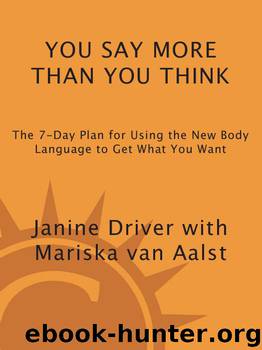You Say More Than You Think: The 7-Day Plan for Using the New Body Language to Get What You Want by Janine Driver; Mariska Van Aalst

Author:Janine Driver; Mariska Van Aalst
Language: eng
Format: mobi
Tags: Language Arts & Disciplines, Self-confidence, Psychology, Communication, Communication Studies, Self-Help, General, Interpersonal Relations, Body language, Social Psychology, Personal Growth, Self-Esteem
ISBN: 9780307453976
Publisher: Random House, Inc.
Published: 2010-02-16T05:00:00+00:00
Once you know a person’s right side, you can use it in many powerful and persuasive ways.
DETECTING RIGHT SIDE CUES
As you test for a person’s “right” side, look for these cues.
Good Side Cues: Shows wrinkled crow’s-feet around the eyes; keeps head straight or tilted to the side; speaks in a normal tone of voice with no additional umms, errs, “you knows,” or other verbal fillers; keeps chin straight or slightly tilted up with the head slightly tilted back; three power zones (throat, belly button, and naughty bits) are open; relaxes shoulders and leans toward you; hands by his side, or on his hips, or if his hands are in his pockets he is either hooking or displaying his thumbs; he uses open-palm gestures that face up; his belly button follows you when you move to this side; both of his feet point to you, or if sitting, he may sit in the figure four with the top leg the farthest away from you (to keep you in his circle of trust).
Bad Side Cues: Wrinkles his forehead or smirks, sticks his tongue out a bit momentarily, bites the inside of his cheek; has trouble speaking (stutters, repeats question, has pauses that don’t belong in the response), uses jumbled words when talking to you, voice lowers and is almost inaudible; grabs his own throat, raises his shoulders, crosses his arms, suddenly leans away from you, grabs his wrist; submerges hands into his pockets with his thumbs inside, fingers are clenched or palms are down; turns his belly button away from you; crosses his ankles, moves one foot angled toward a door or an exit, or if sitting, he may cross his legs or sit in the figure four with the top leg closest to you (to make a wall between you and him).
Download
This site does not store any files on its server. We only index and link to content provided by other sites. Please contact the content providers to delete copyright contents if any and email us, we'll remove relevant links or contents immediately.
Unwinding Anxiety by Judson Brewer(72058)
The Art of Coaching by Elena Aguilar(52249)
The Fast Metabolism Diet Cookbook by Haylie Pomroy(20930)
Rewire Your Anxious Brain by Catherine M. Pittman(18337)
Healthy Aging For Dummies by Brent Agin & Sharon Perkins RN(16935)
Talking to Strangers by Malcolm Gladwell(12916)
The Art of Thinking Clearly by Rolf Dobelli(9951)
Crazy Rich Asians by Kevin Kwan(8912)
Mindhunter: Inside the FBI's Elite Serial Crime Unit by John E. Douglas & Mark Olshaker(8751)
The Compound Effect by Darren Hardy(8544)
Periodization Training for Sports by Tudor Bompa(7947)
Becoming Supernatural by Dr. Joe Dispenza(7869)
Tools of Titans by Timothy Ferriss(7850)
Wonder by R. J. Palacio(7756)
Crystal Healing for Women by Mariah K. Lyons(7734)
Bodyweight Strength Training by Jay Cardiello(7686)
Therapeutic Modalities for Musculoskeletal Injuries, 4E by Craig R. Denegar & Ethan Saliba & Susan Saliba(7606)
Should I Stay or Should I Go? by Ramani Durvasula(7440)
Change Your Questions, Change Your Life by Marilee Adams(7405)
